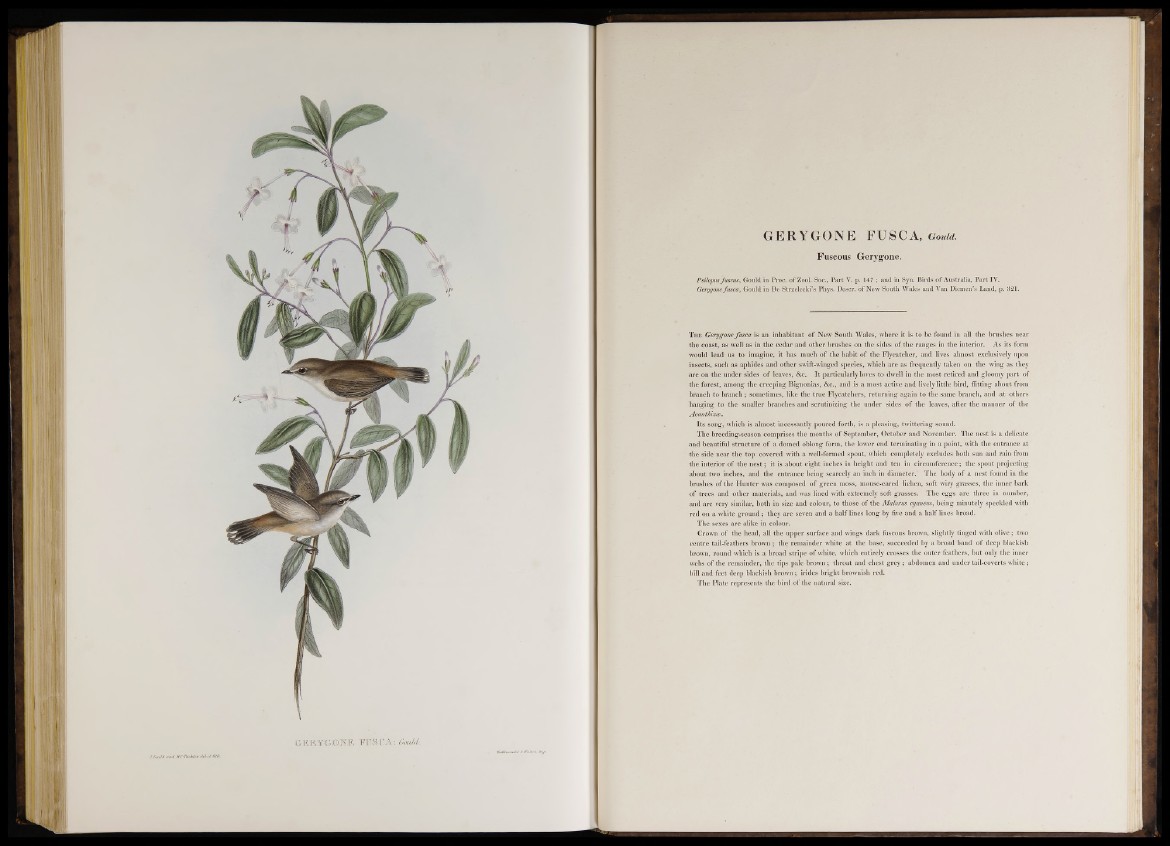
GERYGONE FUSCA, 1
Fuscous Gerygone.
Psilopus fuscus, Gould in Proc. of Zool. Soc., Part V. p. 147 ; and in Syn. Birds of Australia, Part IV.
Gerygone fusca, Gould in De Strzelecki’s Phys. Descr. of New South Wales and Van Diemen’s Land, p. .321.
T h e Gerygone fusca is an inhabitant o f New South Wales, where it is to be found in all the brushes near
the coast, as well as in the cedar and other brushes on the sides o f the ranges in the interior. As its form
would lead us to imagine, it has much o f the habit of the Flycatcher, and lives almost exclusively upon
insects, such as aphides and other swift-winged species, which are as frequently taken on the wing as they
are on the under sides o f leaves, &c. It particularly loves to dwell in the most retired and gloomy part of
the forest, among the creeping Bignonias, &c., and is a most active and lively little bird, flitting about from
branch to branch; sometimes, like the true Flycatchers, returning again to the same branch, and at others
hanging to the smaller branches and scrutinizing the under sides o f the leaves, after the manner of the
Acanthizce.
Its song, which is almost incessantly poured forth, is a pleasing, twittering sound.
The breeding-season comprises the months of September, October and November. The nest is a delicate
and beautiful structure o f a domed oblong form, the lower end terminating in a point, with the entrance at
the side near the top covered with a well-formed spout, which completely excludes both sun and rain from
the interior of the n e st; it is about eight inches in height and ten in circumference; the spout projecting
about two inches, and the entrance being scarcely an inch in diameter.' The body o f a nest found in the
brushes o f the Hunter was composed of green moss, mouse-eared lichen, soft wiry grasses, the inner hark
o f trees and other materials, aud was lined with extremely soft grasses. The eggs are three in number,
and are very similar, both in size and colour, to those o f the Malurus cyaneus, being minutely speckled with
red on a white ground; they are seven and a half lines long by five and a half lines broad.
The sexes are alike in colour.
Crown of the head, all the upper surface and wings dark fuscous brown, slightly tinged with olive; two
centre tail-feathers brown ; the remainder white at the base, succeeded by a broad band o f deep blackish
brown, round which is a broad stripe o f white, which entirely crosses the outer feathers, but only the inner
webs of the remainder, the tips pale brown ; throat and chest grey; abdomen and under tail-coverts white;
bill and feet deep blackish brown; irides bright brownish red.
The Plate represents the bird of the natural size.